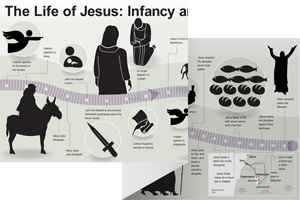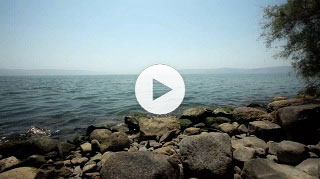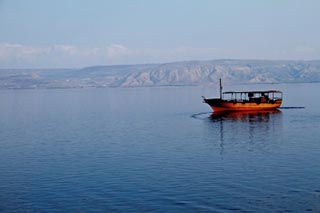14:1–12 Matthew begins this section by recounting the death of John the Baptist. |
14:1 At that time This phrase connects this story with the preceding account (see Matt 13:54–58). Apparently, John’s death occurred close to the time of Jesus’s rejection at Nazareth (compare v. 13).
(compare v. 13).
Herod the tetrarch Refers to Herod Antipas; a tetrarch is one who rules over a fourth of the kingdom. See note on Luke 3:1.
is one who rules over a fourth of the kingdom. See note on Luke 3:1.
 Political Leaders in the New Testament Table
Political Leaders in the New Testament Table
14:3 after arresting John See Matt 4:12 and note. The present passage (vv. 3–11) is a flashback to the events surrounding John the Baptist’s death.
the wife of his brother Philip Or “the one who had been the wife of his brother Philip.”
14:5 the crowd Herod feared the crowd’s response. If they discovered that he killed John, whom they considered a prophet, they might rebel or cause an uprising.
14:6 the daughter of Herodias Identified as Salome by the first-century Jewish historian Josephus (Josephus, Antiquities 18.136).
14:8 coached by her mother Herodias, the other party in the Antipas-Herodias scandal (see Matt 14:3). She, too, was incensed by John’s denunciation of their union and wanted him killed.
the other party in the Antipas-Herodias scandal (see Matt 14:3). She, too, was incensed by John’s denunciation of their union and wanted him killed.
14:9 was distressed Refers to Herod’s fear of the crowd (v. 5); he didn’t want to incite a rebellion.
14:12 took away the corpse and buried it They gave him a proper burial rather than that of an executed criminal.
rather than that of an executed criminal.
14:13–21 Matthew’s Gospel records two mass feedings (compare 15:32–39). In addition to caring about His followers’ spiritual needs, Jesus also evidences concern for their physical well-being. |
14:17 five loaves and two fish A meal that might feed two people. Bread and fish were the staples of a Galilean peasant diet.
14:19 he gave thanks Jesus thanks God for providing the food (compare Luke 24:30; 1 Cor 14:16). The sequence of verbs eulogeō, klaō, didōmi (“give thanks, break, give”) occurs again in Matt 26:26, which may hint that it represented a traditional blessing.
14:20 twelve baskets full One per disciple. In the ot, God fed His people with manna, but there were no edible leftovers (Exod 16:14–21). For other miraculous feedings by prophets, see 1 Kgs 17:8–16; 2 Kgs 4:42–44.
Jesus Feeds 5,000 People | |||
14:21 in addition to women and children The women and children likely added 1,000–3,000 people.
14:22–33 Jesus sends His disciples to the other side of the Sea of Galilee while He goes away to pray. He then comes to them by walking on the surface of the water. For the first time in Matthew’s Gospel, the disciples confess Jesus’ true identity—which Satan and demons have already acknowledged (Matt 4:3, 6; 8:29). The statement here foreshadows the great confession in 16:16. |
 Miracles of Jesus Table
Miracles of Jesus Table
14:22 to the other side Across the Sea of Galilee.
14:23 the mountain Likely refers to a hilly place nearby. The text does not specify a particular mountain.
14:24 many stadia The Greek phrase used here, stadious pollous, does not give an exact distance but simply indicates “many stadia.” A stadion is about 1/8 of a Roman mile, or roughly 600 feet (185 meters). This suggests that the boat was a significant distance from the shore. John’s parallel account gives a more specific distance of 25–30 stadia (John 6:19).
is about 1/8 of a Roman mile, or roughly 600 feet (185 meters). This suggests that the boat was a significant distance from the shore. John’s parallel account gives a more specific distance of 25–30 stadia (John 6:19).
14:25 in the fourth watch Romans divided the 12-hour span between 6 p.m. and 6 a.m. into four watches of three hours each. The fourth watch (mentioned here in the Greek text of Matthew) was 3–6 a.m.
walking on the sea This demonstration of power over the sea served as a sign of Jesus’ deity. See note on Matt 8:26.
Miracles at the Sea of Galilee | |
Jesus Calms a Storm | |
Jesus Walks on Water | |
The Miraculous Catch of Fish | |
A Second Miraculous Catch | |
14:27 I am he Matthew may be employing this phrase in a colloquial manner (“it’s me”). Alternatively, he could be intentionally using the Greek translation of the divine name (egō eimi) revealed in Exod 3:14.
14:28 Peter answered him and said This account establishes Peter as the spokesman of the disciples in Matthew’s Gospel.
Lord Peter respectfully and fearfully addresses Jesus; this address may indicate that Peter is addressing Jesus as Yahweh (see note on 8:2).
if it is you The disciples did not recognize Jesus at this point.
14:31 You of little faith See 6:30 and note.
14:33 Truly you are the Son of God The first apostolic confession of Jesus’ divine messiahship. This answers the disciples’ question from their previous incident out on the lake (8:27).
14:34–36 The people in this episode exercise great faith, believing that Jesus can heal them if they simply touch His clothes (compare 9:21). |
14:34 Gennesaret A town on the northwest shore of the Sea of Galilee.
on the northwest shore of the Sea of Galilee.
14:36 the edge of his cloak Compare 9:20–21.
all those who touched it were cured They believed that Jesus’ power emanated from Him, and that by touching Him they would be healed.

|
About Faithlife Study BibleFaithlife Study Bible (FSB) is your guide to the ancient world of the Old and New Testaments, with study notes and articles that draw from a wide range of academic research. FSB helps you learn how to think about interpretation methods and issues so that you can gain a deeper understanding of the text. |
| Copyright |
Copyright 2012 Logos Bible Software. |
| Support Info | fsb |
 Loading…
Loading…





